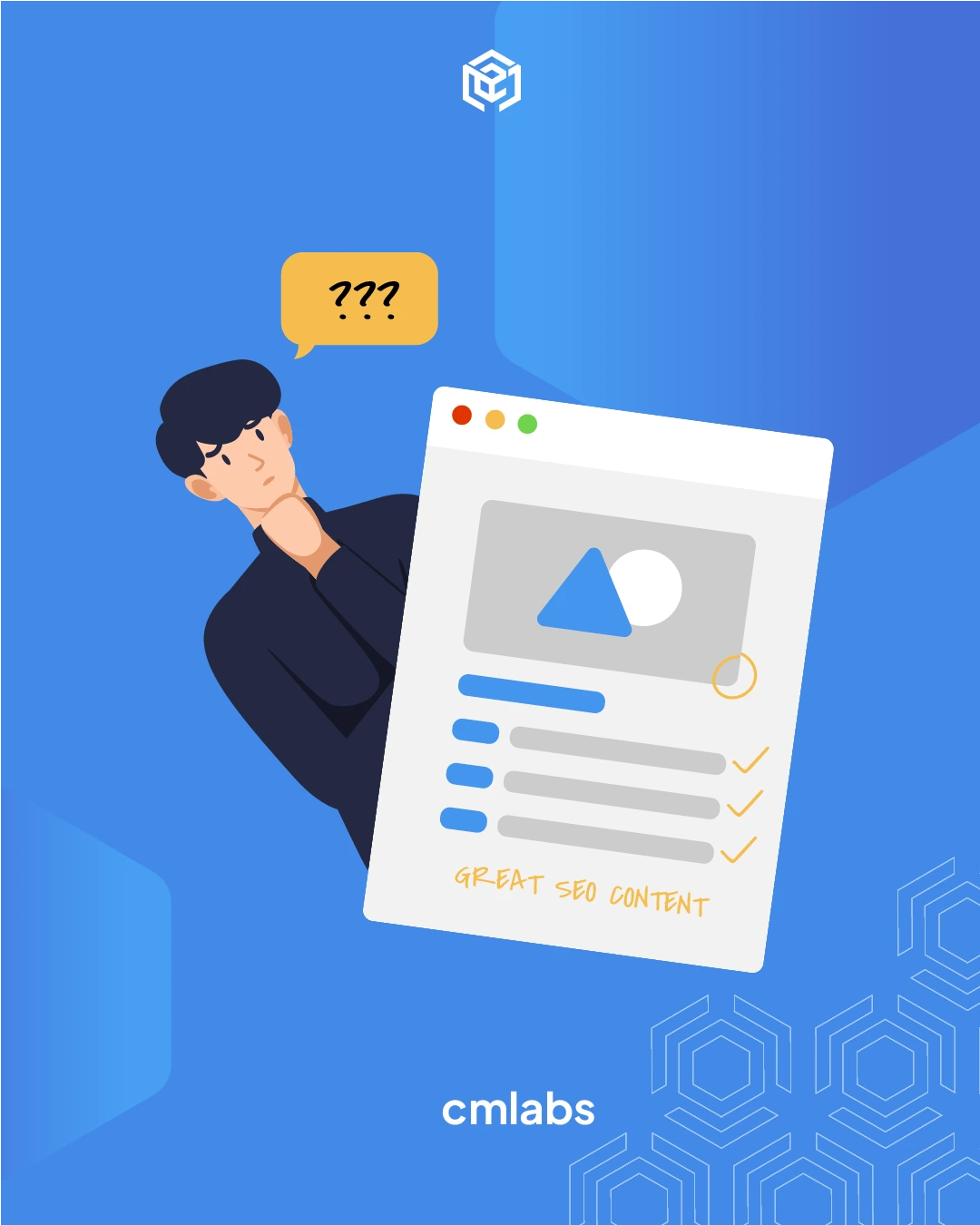We use cookies
This site uses cookies from cmlabs to deliver and enhance the quality of its services and to analyze traffic..
SEO SERVICES
Conduct in-depth technical website audits, strategically develop website projections, and increase your website authority.
ASO SERVICES
Elevate Your App’s Presence with Our Expert ASO Services – Boost Visibility and Drive Downloads!
WRITING SERVICES
We offer a variety of writing services to suit different business necessities. Reach broader audiences or lead specific industries? We've got you covered!
Get relevantly positive media exposure from bloggers and online publishers to increase your brand mentions on search engine results pages.
SEOlutions
A unified source of truth!
SEO & Digital Maternity Solution
SEO & Digital Maternity Solution: Leverage Cross-Platform Insights to Elevate Your Strategy with Expert Consultation
SEO & Digital Maternity Solution
Data Solution options:
Starting from Rp200 mio
Reinventing how a company get creative treatments
A new way to get your creative needs done. Agile team, efficient cost, and expedient way in a flexible yet scalable subscription plan!
Creative-as-a-Services
CaaS package options:
Based on Subscription
Pioneer in digital marketing software powerhouse
We’re excited to unveil our new range of Tech Solutions designed to drive your digital success. Whether you’re looking to enhance your website’s performance, streamline your tech stack, or unlock deeper insights from your data, we’ve got you covered.
Starting from Rp250 mio
Our Clients
Research and innovation center for digital transformation
Digital marketing combines technical skills and business knowledge at every stage. For marketing teams, improving budget management efficiency is crucial, as time is an invaluable resource that should be used wisely. At Sequence, we are dedicated to empowering you to optimize efficiency and strategic planning, ultimately enhancing the impact of your digital marketing efforts.
Subscription-based (IDR1,800/keyword)
Our Clients
BeyondSEO
References
SEO Tools for Webmasters
SEO Tools for Writers
SEO Tools
FIND THE SUITABLE PARTNERSHIP FOR YOUR COMPANY
Check out which cmlabs partnership program suits your company
WHITE LABEL SEO
for CorporateYour company is granted exclusive partnership rights to provide SEO services to our important clients, and we will provide a dedicated backend team to support your efforts.
AFFILIATE PROGRAM
for BizdevA new affiliate program is being introduced for skilled marketers and individuals with strong networks, offering commissions of up to 7% for generating profits independently.
DIGITAL AGENCY
for Marketing Partnerscmlabs is an essential partner for digital agencies, providing a unique selling proposition in Search Engine Optimization (SEO).
BACKLINK PARTNERSHIP
for Media / BloggerWe have a vast database of bloggers and media outlets across Indonesia, categorized by region and media type, giving our clients an edge in managing their media and SEO activities.
OFFICIAL TRAINING
We provide ongoing professional development and support to SEO professionals to ensure they are equipped to meet market demands.
JOIN AS CONTRIBUTOR
for Content WriterGreat opportunity for SEO Writers around the world. T&C applied!
ACADEMIC PARTNERSHIP
Through partnerships with universities in Indonesia, cmlabs has helped align academic curricula with industry demands.
Partnership
Sector & Industries
Tell us your SEO needs, our marketing team will help you find the best solution
As an alternative, you can schedule a conference call with our team
Schedule a Meeting?Contact
Survey
We use cookies
This site uses cookies from cmlabs to deliver and enhance the quality of its services and to analyze traffic..
Last updated: Aug 25, 2023
Google Web Stories are interactive content that serves to share information with users through pages that can display images, text, and audio. Previously, the Web Stories format was known as AMP Stories.
Web Stories can be indexed and appear as relevant search results.
Web Stories can appear in standard search results or as a carousel in Google Discover. Apart from that, you can also add them to newsletters and provide links that connect the site with social media accounts.

Web Stories can be used to improve the SEO strategy for your website. Creating Web Stories content needs to be considered because this can provide an opportunity for your site to appear in Google Images and SERPs.
This means that users will find your website easier. Apart from that, you can customize web stories by adding a CTA or some links that can drive traffic to your website.
If you want to use new innovations that can provide a pleasant experience for users, web stories can be your best option.
Mobile and desktop users can view your Web Stories in full screen, which can create the feeling that users are in the stories you create.
Like Instagram, Facebook and Google Discover, you can share stories in a way that is more fun for users by using Web Stories.
According to the data presented by Neil Patel, the average user spends around 5 hours per day scrolling through content on their mobile device.
Creating stories with an elegant design and useful content can make users feel comfortable when viewing content from your Web stories.
The first step that needs to be done is to make a storyboard and narrative draft. This is important to do because it can help you develop a more mature Web Stories content concept.
Google also provides script templates that can be used to construct storyboard narration.
After drafting the content narration, choose an editor to use to create your Web Stories.
If you have what it takes to be a developer, you can follow the AMP tutorial, which will walk you through the process of creating Stories using custom functions.
However, if you don't have the skills as a developer, you can use an editor that doesn't require coding in the process of creating Web Stories.
If you are a WordPress user, you can use the Web Stories plugin provided by WordPress.
After determining the editor, start creating Web Stories based on the concepts you have in mind.
The last thing you need to do is activate Google Web Stories. To determine whether Web Stories are working properly, you can check them with a number of tools, such as the following:
WDYT, you like my article?
Couldn't find result for "Mulki" try to search with different keyword
Suggestion:
Tell us your SEO needs, our marketing team will help you find the best solution
As an alternative, you can schedule a conference call with our team
Schedule a Meeting?



cmlabs Jakarta Jl. Pluit Kencana Raya No.63, Pluit, Penjaringan, Jakarta Utara, DKI Jakarta, 14450, Indonesia
(+62) 21-666-04470These strategic alliances allow us to offer our clients a wider range of SEO innovative solutions and exceptional service.

Psst! Hey there, SEO Stats and Tools SEO company! If you've ever planned of conquering the Indonesia market, you've come to the right place!